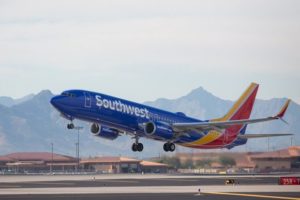Alaska Air’s (NYSE: ALK) 2016 acquisition of Virgin America set off a chain reaction that dramatically intensified competition among airlines in California. Alaska Airlines started the process by launching dozens of new California routes, with a particular emphasis on routes from the Bay Area, which was Virgin America’s primary stronghold.
Several competitors soon responded with new flights of their own, as they worked to protect their market share in California. Southwest Airlines (NYSE: LUV) was particularly aggressive in this regard. This caused a fare war to break out.
However, with fuel prices rising and profitability eroding — particularly for Alaska Airlines — the two carriers seem to have called a truce. That’s good news for shareholders, as a more rational competitive environment will help both carriers get unit revenue growing again.

Alaska Airlines’ profitability has eroded dramatically over the past year. Image source: Alaska Airlines.
Competition takes a toll
Southwest Airlines operates more daily flights to and from California than any other carrier. Thus, it’s not surprising that it felt threatened by Alaska Air’s aggressive move into the California market. Over the past year or so, Southwest has added dozens of daily flights in California (mainly Northern California).
The increased competitive intensity on California routes drove airfares down significantly. As a result, Alaska Air has faced severe margin pressure since the second half of 2017. Initially, Southwest Airlines seemed to feel no ill effects, but it too has struggled to grow unit revenue since the beginning of 2018.
Given that the price of jet fuel has skyrocketed this year, Alaska and Southwest cannot afford a prolonged bout of unit revenue weakness. Alaska Air began implementing major capacity cuts in March. And in the past month and a half, both carriers have announced additional moves that will reduce the level of competition between them to a more sustainable level.
Pulling out of noncore markets
In late April, Southwest Airlines agreed to lease Alaska Airlines’ four within-perimeter slot pairs at Washington, D.C.’s Reagan Airport and its six slot pairs at New York’s LaGuardia Airport. The lease begins this fall and runs for 10 years.

Southwest will expand in New York and Washington, D.C., in November. Image source: Southwest Airlines.
None of these slots can be used for flights to the West Coast, making them a poor strategic fit for Alaska Airlines, which describes itself as a West Coast airline. Alaska (and Virgin America before it) has used the slots at both airports for flights to Dallas Love Field, Southwest Airlines’ home airport. This was a competitive battle that Alaska was bound to lose: The Love Field routes to New York and Washington, D.C. have never been profitable.
Thus, this slot lease agreement is a clear win-win. Alaska will get out of money-losing markets and will gain some steady lease income, while Southwest Airlines will have one less competitor to face on two key routes and will be able to expand in New York and Washington, D.C., two important markets.
Last week, Southwest Airlines announced the latest changes to its flight schedule, including a handful of new California routes and additional flights on routes including San Jose-Portland, Oregon and San Jose-Orange County, California. This might make it seem like Southwest is still putting the screws to Alaska Airlines in California.
However, Southwest Airlines will simultaneously cancel its San Francisco-Portland and San Francisco-Orange County routes. Alaska has its main Northern California hub in San Francisco, so it will benefit from Southwest’s capacity shift away from San Francisco.
Alaska Airlines needed this badly
Last quarter, Alaska Air Group posted a shockingly low pre-tax margin of 1.3%, down from 11% a year earlier. (Profitability would have been even worse but for the favorable timing of Easter.) Some of this margin pressure related to merger pains and rising fuel costs, but the intensity of competition on many of Alaska’s routes also played a major role.
Southwest Airlines’ profitability held up much better last quarter, although its margin erosion is on pace to accelerate in the second quarter.
Both carriers will benefit as they retreat from markets where the other is stronger. Alaska will be the bigger winner, though, because it is less than half of Southwest’s size and hasn’t had as many high-performing routes to balance out the impact of unit revenue weakness in California. Indeed, Alaska Air now appears to be primed for a comeback starting in late 2018.


